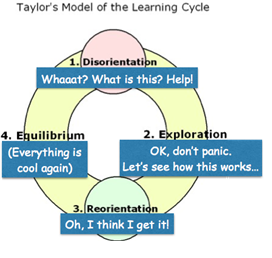Learning Journal 3
1. Two “things” that stood out
- To make direct conclusions without assuming anything. This is actually harder than it sounds. Direct conclusions are the simplest way to inspect data and experimental results, and should only reflect a raw interpretation of the result without making any assumptions.
- When dealing with complex data and outcomes from several experiments, the approach taken should be to deal with parts of the data separately instead of trying to grasp all the data at once.
|
Two things that stood out |
Type of knowledge |
What makes these things stand out for you |
Evidence/how you would test someone on this |
|
|
1 |
To make direct conclusions without assuming anything. This is actually harder than it sounds. Direct conclusions are the simplest way to inspect data and experimental results, and should only reflect a raw interpretation of the result without making any assumptions. |
Procedural/Skills |
When I was introduced to this, it was kind of a new way to look at data. Though I have been interpreting data before to make conclusions previously, I was not looking at data only, but also assuming many things. I really like this way of interpretation, since it can be preventive to false and excessive conclusions. Direct conclusions should reflect what data tell and not what it might tell. | It could be tested through an assignment where the students had to find examples of both direct conclusions and conclusions based on assumptions stated in a scientific article and clearly state which one it was. If the students also were able to make direct conclusions from data themselves, I would consider it proof that the students had acquired this skill. |
|
2 |
When dealing with complex data and outcomes from several experiments, the approach taken should be to deal with parts of the data separately instead of trying to grasp all the data at once. |
Metacognitive |
Dealing with a lot of data is difficult, especially when it comes from many experiments. Therefore, by investigating a specific portion of data to answer a specific question, prediction or hypothesis can assist to keep focused on relevant data only. This approach makes complex data easier to “digest” and having knowledge on how to approach such a problem can be extremely beneficial when dealing with complex data. |
Learning Journal 4 is posted on Arik’s blog
Learning Journal 5
The single most important thing that I have learned in this course is how to interpret data without making any assumptions. I think I have mentioned this before in one of my other LJs, but this is a skill I can apply, and improve, throughout the remainder of my education and future work. To me it is one of the most important tools one can possess working in science, since a conclusion based on data should only reflect the actual experimental result and e.g. not the interpreter’s background knowledge or desire to see a specific point. This is also something I really struggled with at first, but now, at the end of the course, I feel I have obtained this skill.
Being a learner, realizing that the disorientation phase is unavoidable, whether it occurs in the beginning of a process or later, has been a great help to me. Especially when dealing with knowledge that has to be incorporated into e.g. a model or in a project, such as the final project. The first model I would make would not be perfect, but I would understand that it is actually possible to make such a model. When I was writing the final project, knowing I will be disorientated at some point (or at several points) made the impact of disorientation less than what could have been – it is simply a part of the writing process! However, when you know the problem you are dealing with is solvable, it would encourage me to try out several different solutions and the result was often that not only did I solve the problem I was dealing with, I also came up with the best solution instead of just a solution.
Besides studying, I also enjoy running. When I first started running, even the small distances could be difficult to do in the speed I felt I could run in. By slowing down the speed, not only did the distances become easier to run, I could also run much longer! Whenever I felt like stopping for a break while I was running, just by slowing down for a bit I would be giving myself a break and generate a bit more determination, and I would be able to run the entire distance – and I would enjoy it even more!

